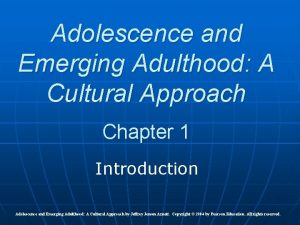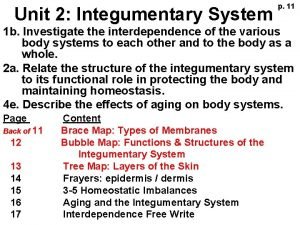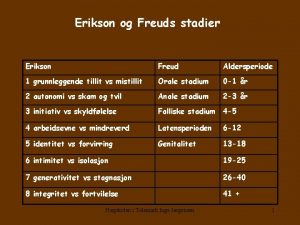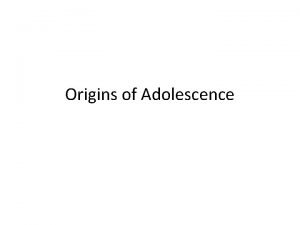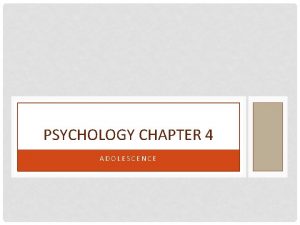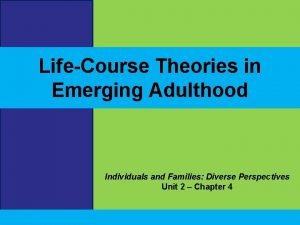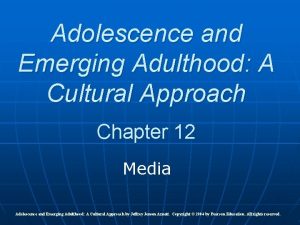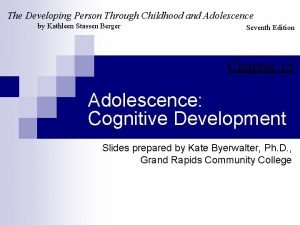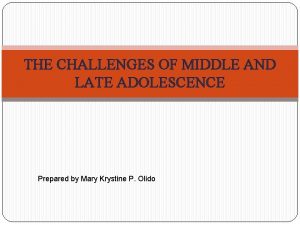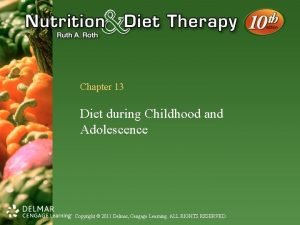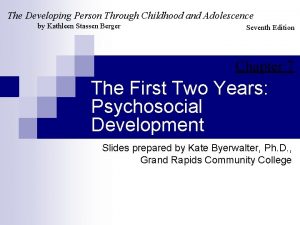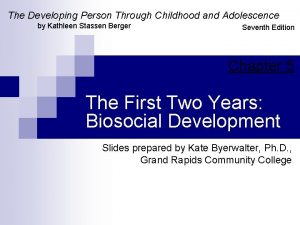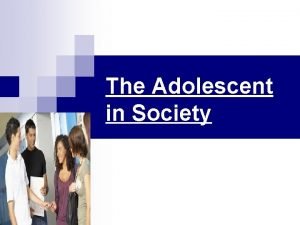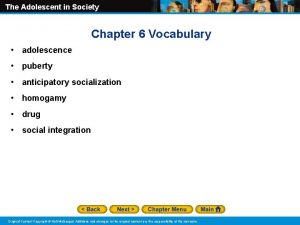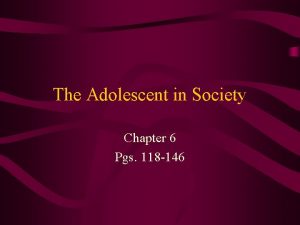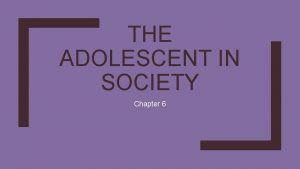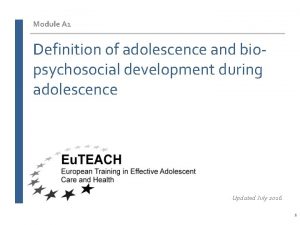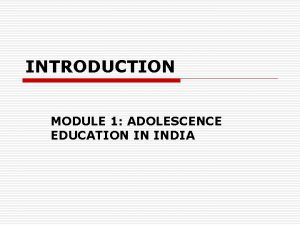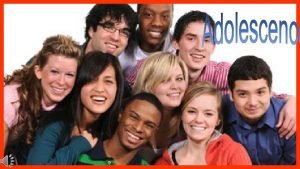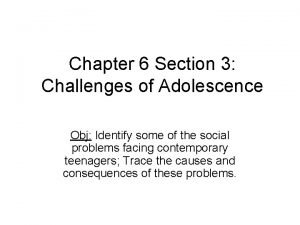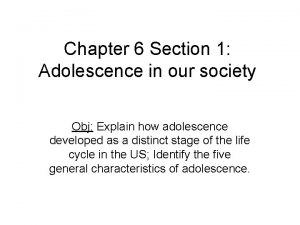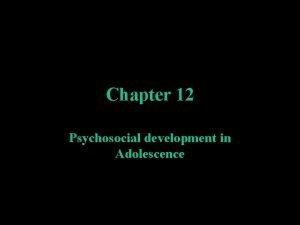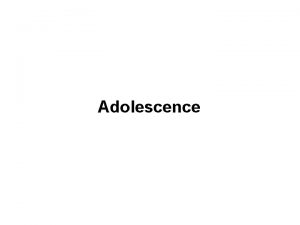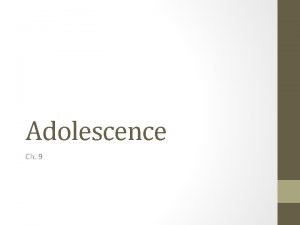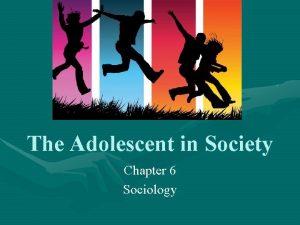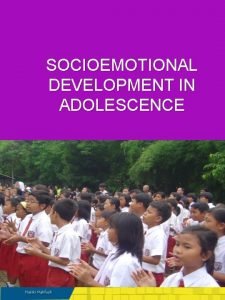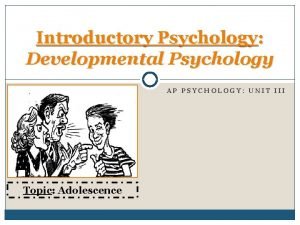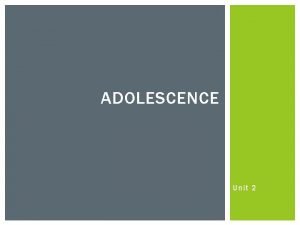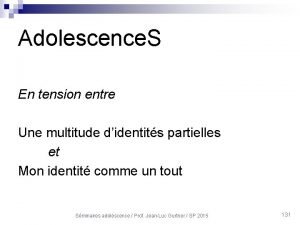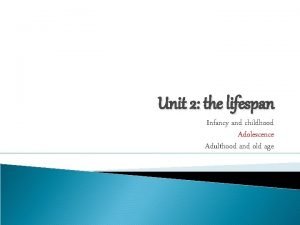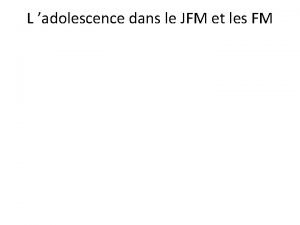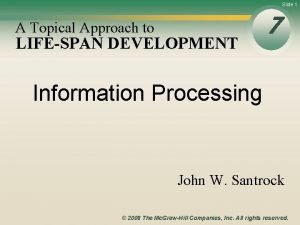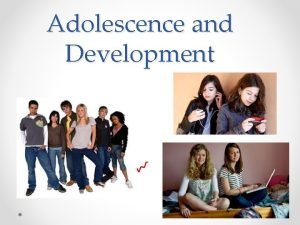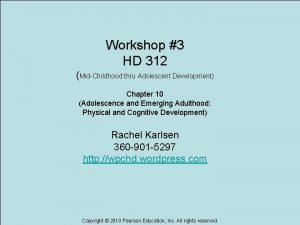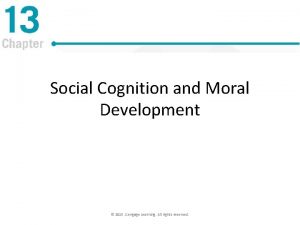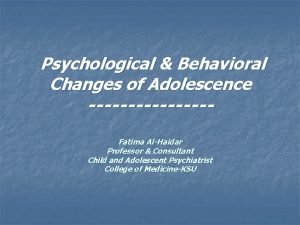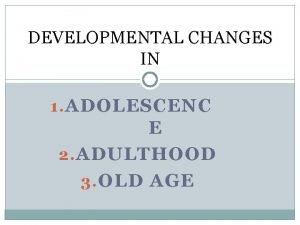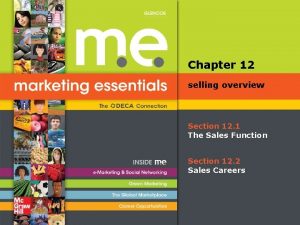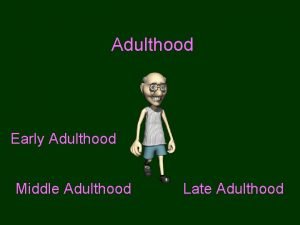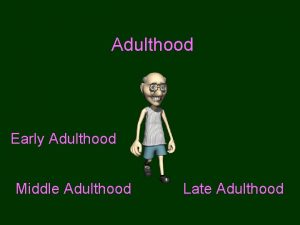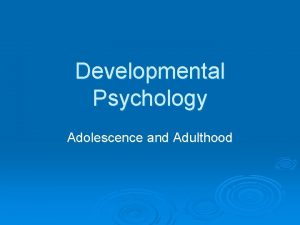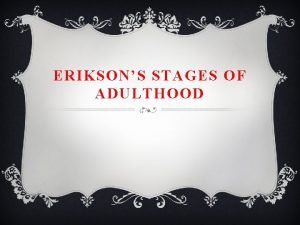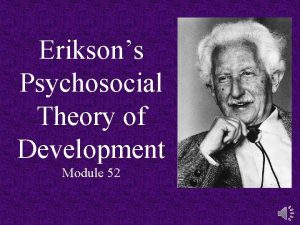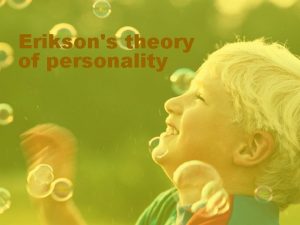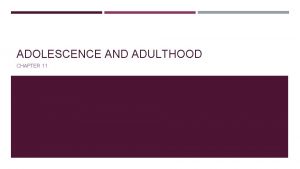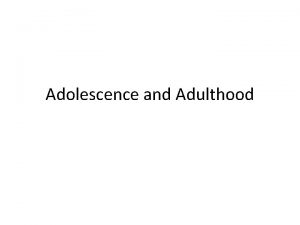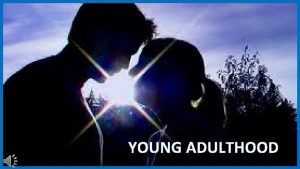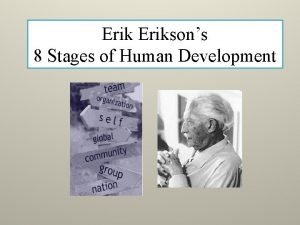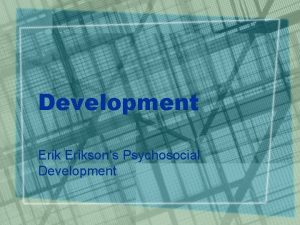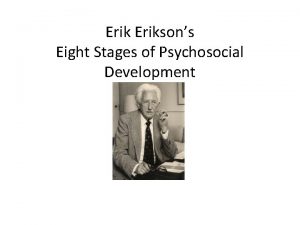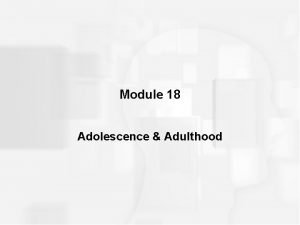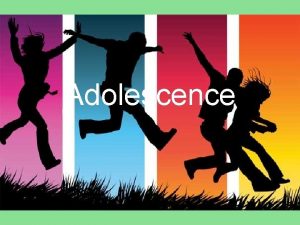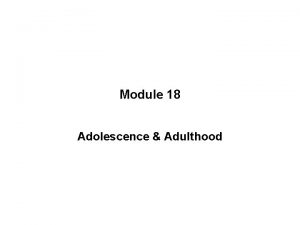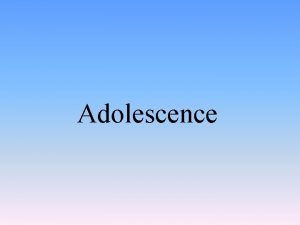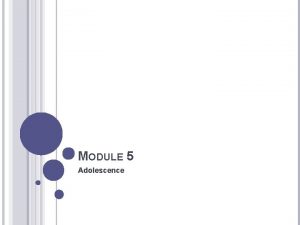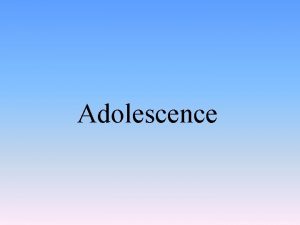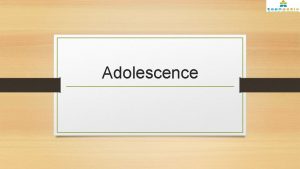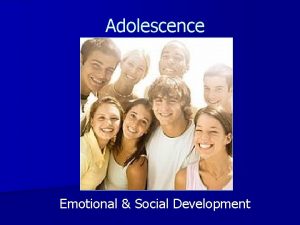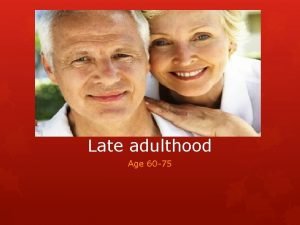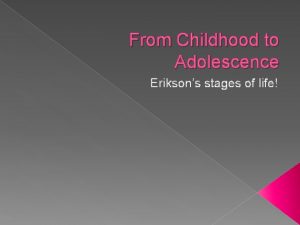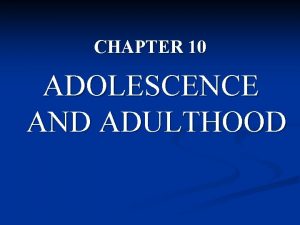Adolescence and Adulthood Chapter 11 OVERVIEW Eriksons theory




















































- Slides: 52

Adolescence and Adulthood Chapter 11

OVERVIEW ® Erikson’s theory of psychosocial development ® Adolescence ® Storm and Stress Model ® Adolescent Generalization Gap ® Physical, Cognitive, & Socioemotional Development ® Gender Identity ® Adulthood ® Physical, Sensory, & Sexual Changes ® Theories of Aging ® Health in Late Adulthood ® Death & Dying

Erikson: The Search for Self ® Based on Freud’s psychosexual stages of development, Erikson (1902 -1994) developed his own Psychosocial theory of development

Erikson: The Search for Self • A healthy personality • actively masters the environment • shows a certain unity of personality, • is able to perceive the world and self correctly • Childhood is defined by the initial absence of these characteristics and by their gradual development in complex steps of increasing differentiation • Growing up is a process of achieving Ego Identity - a set of thoughts, feelings, values, attitudes, and behaviours that defines a person’s self

Erikson: The Search for Self • Ego Identity has 2 aspects: 1. First/inner-focused aspect is knowing and accepting oneself 2. Second/outer-focused aspect is the individual’s recognition of and identification with his or her culture • People who have attained ego identity have a clear picture and an acceptance of both their inner essence and the group culture in which they live

Erikson’s Psychosocial Theory of Development • Psychosocial theory of development - the demands of society at each stage of development promote the development of a unique personality and ensure that individuals acquire attitudes and skills that help them become active and contributing members of their society • According to Erikson, a basic psychosocial conflict, which is resolved along a continuum from positive to negative, determines healthy or maladaptive outcomes at each stage

Erikson’s Psychosocial Theory of Development • Each stage is a struggle between two opposite or conflicting personality characteristics • E. G. : Trust Continuum ----------------------------- Complete Trust Complete Mistrust

Erikson’s Psychosocial Theory: Stage 1 ® Birth to 18 months ® Basic trust vs. mistrust ® If needs are met, child learns world is predictable and safe ® If needs are not met in stage 1, distrust in the world develops ® Significant relationship = mother

Erikson’s Psychosocial Theory: Stage 2 ® 18 months to 3 years ® Autonomy vs. shame & doubt ® Success in tasks leads to autonomy ® Failure in stage 2 leads to fears and a sense of doubt ® Significant relationship = parents/caregivers

Erikson’s Psychosocial Theory: Stage 3 ® 3 to 6 years of age ® Initiative vs. guilt ® A sense of mastery develops if the child successfully exercises enthusiasm ® Failure leads to dependence and regret ® Significant relationships = family including siblings

Erikson’s Psychosocial Theory: Stage 4 ® 6 to 12 years of age ® Industry vs. inferiority ® The child gains a sense of confidence ® Failure in stage 4 leads to feelings of inferiority and incompetence ® Significant relationships = school

Erikson’s Psychosocial Theory: Stage 5 ® Adolescence ® Identity vs. role confusion ® Growth and turmoil of adolescence creates an “identity crisis” ® Crisis is resolved by forming an identity ® Failure to form an identity leads to confusion about adult roles ® Significant relationships = peer groups

Erikson’s Psychosocial Theory: Stage 6 ® Young adulthood ® Intimacy vs. isolation ® Young adults must commit to lasting intimate and caring relationships ® The alternative is isolation ® Significant relationship = romantic partner

Erikson’s Psychosocial Theory: Stage 7 ® Middle adulthood ® Generativity vs. stagnation ® Awareness of own mortality ® Hope to convey information, love, and security to the next generation ® Failure leads to stagnation and self-absorption ® Significant relationships = family (children)

Erikson’s Psychosocial Theory: Stage 8 ® Late adulthood ® Integrity vs. despair ® the person assesses whether existence is meaningful and happy, or wasteful and unproductive ® The answer leads to fulfillment or regret ® Significant relationship = humankind/ society

Definitions ® Adolescence: ® Period extending from the onset of puberty to early adulthood. ® Generally occurs between ages 12 and 20 ® Characterized by physical, cognitive, emotional, and social changes ® Puberty: ® Period of time when the reproductive system matures ® Only one aspect of adolescence

Question • Describe your adolescence in three words…

Adolescence: Storm and Stress Model ® G. Stanley Hall – father of the scientific study of adolescence ® Published Adolescence in 1904 ® Storm and Stress model – adolescence is characterized by a great deal of conflict due to hormonal changes and the conflicting demands of adulthood and childhood

Offer et al. (1998) ® Research Question: ® Is the storm & stress stereotype of adolescence accurate? ® Method: ® Cross cultural sample of adolescents ® Survey of self-image, emotions, social relationships , attitudes. ® Results: ® 73% reported no significant psychological difficulties

What Psychologists Think ® Not necessarily a time of great psychological turmoil ® No greater incidence of psychological disturbances compared to the rest of the population. ® Culture plays a significant role in the way adolescence is experienced

Question on Stereotypes What are the most common stereotypes of adolescents?

Adolescent generalization gap ® Adelson (1979) ® Widespread generalizations about adolescents have developed that are based on information about highly visible groups of adolescents

Physical Development

Physical Development ® Puberty is the average at which reproductive systems mature ® Girls enter puberty about two years before boys ® Hormones trigger development of secondary sexual characteristics, physical features that differentiate the sexes

Hormones & Puberty ® Hormones: ® Chemical substances secreted by the endocrine glands and carried through the body by the bloodstream. ® Two Classes of Sex Hormones: ®Androgens: (primarily male) l l Increases 18 -fold in males Increases 2 fold in female ®Estrogens: (primarily female) l l Increases 8 -fold in females Increases 2 fold in men

Determinants of Puberty ® Heredity ® Genes determine the range for the onset of puberty in an individual ® Environment ® Factors such as nutrition, exercise, exposure to growth hormones, exposure to toxins, etc. can affect the onset of puberty.

Effects of Early Onset Puberty ® Early Maturing Males: ® More positive self perception during adolescence ® More successful peer relations ® Tendency to engage in alcohol, drug use, smoking ® Weaker sense of personal identity in adulthood ® Early Maturing Females: ® More positive self perception during early adolescence ® Less positive self perception during late adolescence ® Regarded by peers as sexually active/promiscuous ® Socially popular ® Increased negative behaviors and depression ® Lower educational and occupational goals

Adolescent Cognitive Development

Cognitive Development ® Formal Operational Thought ® At times manifests as argumentative ® Attributes unlimited power to own thoughts ® Adolescent egocentrism ® Most apparent during early-mid adolescence ® Allows teens to break away from parents ® Leads to two cognitive distortions: Imaginary Audience ® Personal fable ®

Gender Differences in Cognition ® Minimal cognitive differences between male and female adolescents on measures of cognitive ability ® Individual variability is high ® Small group differences in performance have been reported in certain special populations.

Socioemotional Development

Socioemotional Development ® Childhood social interactions and cognitive development affect adolescent social adjustment. ® Parents and peers are important influences on self-esteem and personality ® Adolescents’ attitudes fall somewhere between those of their parents and peers

Discussion: ® Who do you think was more influential in your life, parents or peers? ® Were peers more influential in some areas and your parents in other areas?

Friendship in adolescence ® Children and adolescents who have friends tend to be more socially competent ® When friendships fall apart, a child’s selfconfidence is undermined

Friendship in Adolescence ® Functions ® Exposure to ideas and activities ® Ego support/encouragement ® Comparison ® Intimacy/self-disclosure ® Feelings of acceptance ® Learning reciprocal intimacy (Sets stage for adult intimacy) ® Developmental changes ® Increased intimacy and selectivity in adolescence

Gender Identity

The Search for Gender Identity ® Gender identity is a person’s sense of being male or female ® Gender Roles are a set of expectations that prescribes how females and males should think, act, and feel

Word Game ® CIRCLE Ø Female ® TRIANGLE Ø Male ® EAGLE Ø Male ® RABBIT Ø ? ® TIGER Ø Male ® DARK Ø Male ® LIGHT Ø Female ® BOOK Ø Male ® SPOON Ø Female ® CLOUD Ø Female

Gender Role Stereotypes of American University Students (Broverman et al. , 1972) FEMININE MASCULINE Nesbitt & Penn (2000) agreement Not aggressive Not independent Emotional Appearance focus Illogical Home oriented Sneaky Gentle Never acts as a leader Sensitive Aggressive Independent Not emotional Not app. focused Logical Worldy Direct Rough Always acts as a leader Insensitive Yes Yes No No Yes Yes

The Search for Gender Identity ® During adolescence, gender intensification may take place ® This is becoming extreme in one’s orientation toward maleness and femaleness

Gender Identity ® In recent years, many men and women have adopted androgynous behaviours that represent a blend of stereotypically male and female characteristics ® But we still live in a gendered society with nearly impossible standards of what it means to be a man or a woman

ADULTHOOD

Adulthood: Physical Changes General ® Longer life spans ® Less research with adults

Adulthood: Physical Changes Fitness Changes ® 18 -25: peak functioning, childbearing ® 25 -40: good functioning; some loss of agility and speed ® 40 -65: early signs of physical decline ® >65: significant physical decline

Adulthood: Sensory Changes ® Early adulthood: sensory abilities remain stable ® 40 -50: sensory loss

Adulthood: Sexual Changes ® Sexual behaviours change with age ® Young adulthood: Family and work issues ® Middle Adulthood: menopause and testosterone levels decrease

Theories of Aging ® Heredity ® Genetic makeup inherited from our parents ® External Factors ® Lifestyle ® Physiology ® Combination of hereditary and environmental

Theories of Aging: Heredity ® APOPTOSIS: the process by which cells kill themselves ® Telomeres = end segments of DNA ® Cells grow older each time they divide because the telomeres shorten ® Cessation of telomere division may be a possible explanation of aging

Theories of Aging: Physiology ® Wear-and-Tear: body simply wears out from overuse ® Homeostatic: body’s ability to adjust to stress decreases with age

Health in Late Adulthood ® Many elderly lead healthy lives ® However, aging adults face many possible health changes ® Dementias are progressive impairment of mental functioning

Health in Late Adulthood Alzheimer’s ® Irreversible dementia ® memory loss, language deterioration, poor visual/spatial skills, an indifferent attitude

Death and Dying ® People’s overall health deteriorates with age ® terminal drop, rapid drop in intellectual functioning the year before death ® Thanatology is the study of the psychological and medical aspects of death and dying
 Industry vs inferiority example
Industry vs inferiority example Adolescence and emerging adulthood a cultural approach
Adolescence and emerging adulthood a cultural approach Infancy childhood adolescence adulthood old age
Infancy childhood adolescence adulthood old age Sigmund freud and erik erikson
Sigmund freud and erik erikson Freud stadier
Freud stadier Dominant values
Dominant values Chapter 4 adolescence psychology
Chapter 4 adolescence psychology Chapter 4 adolescence psychology
Chapter 4 adolescence psychology Levinson's stages
Levinson's stages Jeffrey arnett emerging adulthood theory
Jeffrey arnett emerging adulthood theory Adolescent egocentrism
Adolescent egocentrism Fast mapping
Fast mapping Challenge of middle and late adolescence
Challenge of middle and late adolescence Eating a balanced diet during childhood and adolescence
Eating a balanced diet during childhood and adolescence The developing person through childhood and adolescence
The developing person through childhood and adolescence Early childhood adolescence
Early childhood adolescence Transient exuberance definition
Transient exuberance definition Chapter 17 overview elements and their properties
Chapter 17 overview elements and their properties Dating serves several important functions that include
Dating serves several important functions that include Adolescence vocabulary
Adolescence vocabulary Chapter 6 the adolescent in society
Chapter 6 the adolescent in society Undefined status adolescence
Undefined status adolescence Brain development adolescence
Brain development adolescence Moral development in adolescence
Moral development in adolescence Late adolescence
Late adolescence Objectives of adolescence education
Objectives of adolescence education Oral sensory stage
Oral sensory stage Adolescence period?
Adolescence period? Social integration by emile durkheim
Social integration by emile durkheim Adolescence in our society
Adolescence in our society Psychosocial development in adolescence
Psychosocial development in adolescence Physical development
Physical development Developmental tasks for adolescent
Developmental tasks for adolescent Adolescence sociology definition
Adolescence sociology definition Socioemotional changes in adolescence
Socioemotional changes in adolescence Personal fable ap psychology
Personal fable ap psychology Adolescence
Adolescence Les avantages de l'adolescence
Les avantages de l'adolescence Vocabulary activity 4-2 personal development
Vocabulary activity 4-2 personal development Social changes in adolescence
Social changes in adolescence Caloub
Caloub Critical thinking in adolescence
Critical thinking in adolescence Adolescence
Adolescence Adolescent egocentrism
Adolescent egocentrism Womens ministry activities
Womens ministry activities Moral development in adolescence
Moral development in adolescence Emotional development in adolescence
Emotional development in adolescence Main characteristics of adolescence
Main characteristics of adolescence A 23 year old male experienced severe head trauma
A 23 year old male experienced severe head trauma Emt chapter 14 medical overview
Emt chapter 14 medical overview Chapter 9 lesson 2 photosynthesis an overview
Chapter 9 lesson 2 photosynthesis an overview Chapter 12 selling overview
Chapter 12 selling overview Chapter 2 an overview of the financial system
Chapter 2 an overview of the financial system

